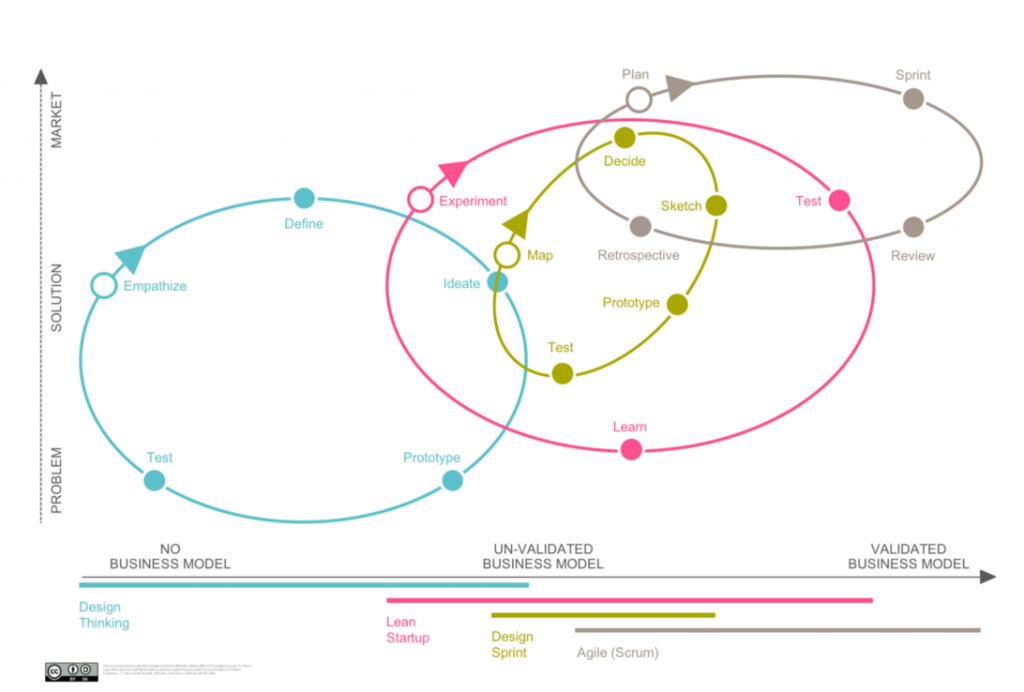Agile, more than a methodology.
The world, the markets, your customers, everything changes extraordinarily fast; let’s understand the COVID crisis as the upward expression of a tremendously uncertain and changing world.
AGILE (as we call it the technology geeks) is simply an extremely flexible working methodology that allows you to adapt or lead changes at the same speed they happen.
There are no 4-year plans in Agile, no annual, half-yearly, or quarterly forecasts; we work with a time window of 1 MONTH. It’s about delivering your company’s best version in an infinite iterative process that lasts no longer than a month.
There are no medium and long-term plans. Still, a backlog of tasks that are continuously reorganized within time units is called sprints.
Maybe there is a lot of unjustified hype. A cardboard manufacturing company had asked me about Agile when they referred to “Lean Manufacturing.” A kind of easy label has been created, generating a lot of noise and understanding the methodology as general-purpose for any company and activity.
Agile makes sense as long as you are in a software development environment, or developing digital products or services, implementing Agile in a factory with machinery will not work for you.
Implementing Agile in a marketing agency is not going to help you either.
If we look at the root of the movement, the message, the philosophy, and the cultural values, they are extraordinarily powerful, logical, and straightforward.
Agile Manifesto.
- Individuals and interactions on processes and tools.
- Software that works instead of complete documentation.
- Ongoing customer collaboration on contract negotiation
- Responding to changes rather than following a closed plan.
By nature, AGILE dramatically simplifies management processes; it is a flexible methodology in all its aspects. It allows you to adopt and generate changes in a fluid way. It is about adopting an incremental development strategy instead of completing the product’s complete planning and execution.
It would say that the only constant in AGILE is changing.
By definition, agile methodologies allow us to adapt the way of working to the project’s conditions, achieving flexibility and immediacy in response to shape the project and its development to the specific circumstances of the environment.
Suppose you have been working with traditional methods. In that case, you know that you are based on short, medium, and long term planning, having a perspective of about a year, any change you make within this forecast means a torment for the whole team and the third parties involved.
These structures are characterized by rigidity, sticking to a closed scope, and minimum quality criteria in document drafting.
However, working with agile methodologies, that unexpected change is the core of your activity; it is not a random event, but a continuous readjustment.
It is an almost real-time response that the client is demanding, which is a reaction to the market change.
The project or service is resolved by small deliveries in which the customer’s participation is active, rethinking aspects that initially were not contemplated.
In essence, companies that bet on this methodology manage their projects in a flexible, autonomous, and effective way, reducing costs and increasing productivity.
Agile methodologies promote direct conversations as opposed to communication-based on written documentation.
The work teams are self-managed, giving freedom to the roles.
Advantages of being Agile.
- Agile methodologies improve customer satisfaction since they will be involved and committed throughout the entire project or service.
- Improved motivation and involvement of the development team since all team members know the project’s status at any time.
- The implementation of agile management allows us to save time and costs.
- Work is done with more incredible speed and efficiency (partial deliveries of the product).
- Agile methodologies allow improving the quality of the product.
- Alert quickly both errors or problems that may occur throughout the project.
- Agile methods will enable us to make our investments profitable. Thanks to early deliveries, the client will have quick access to those functionalities that provide value, accelerating investment return.
We migrate from traditional project methodologies within process-based organizational structures to innovation methodologies, frameworks, and continuous adaptation techniques.

It all depends on the type of project or service to be managed; there are no magic recipes for everyone in everything, but what is certain is that the ideal would be to combine the robustness and quality of traditional methodologies with the flexibility in the change of agile methodologies. Who knows, maybe someday we will achieve it.

Vizologi is a revolutionary AI-generated business strategy tool that offers its users access to advanced features to create and refine start-up ideas quickly.
It generates limitless business ideas, gains insights on markets and competitors, and automates business plan creation.


